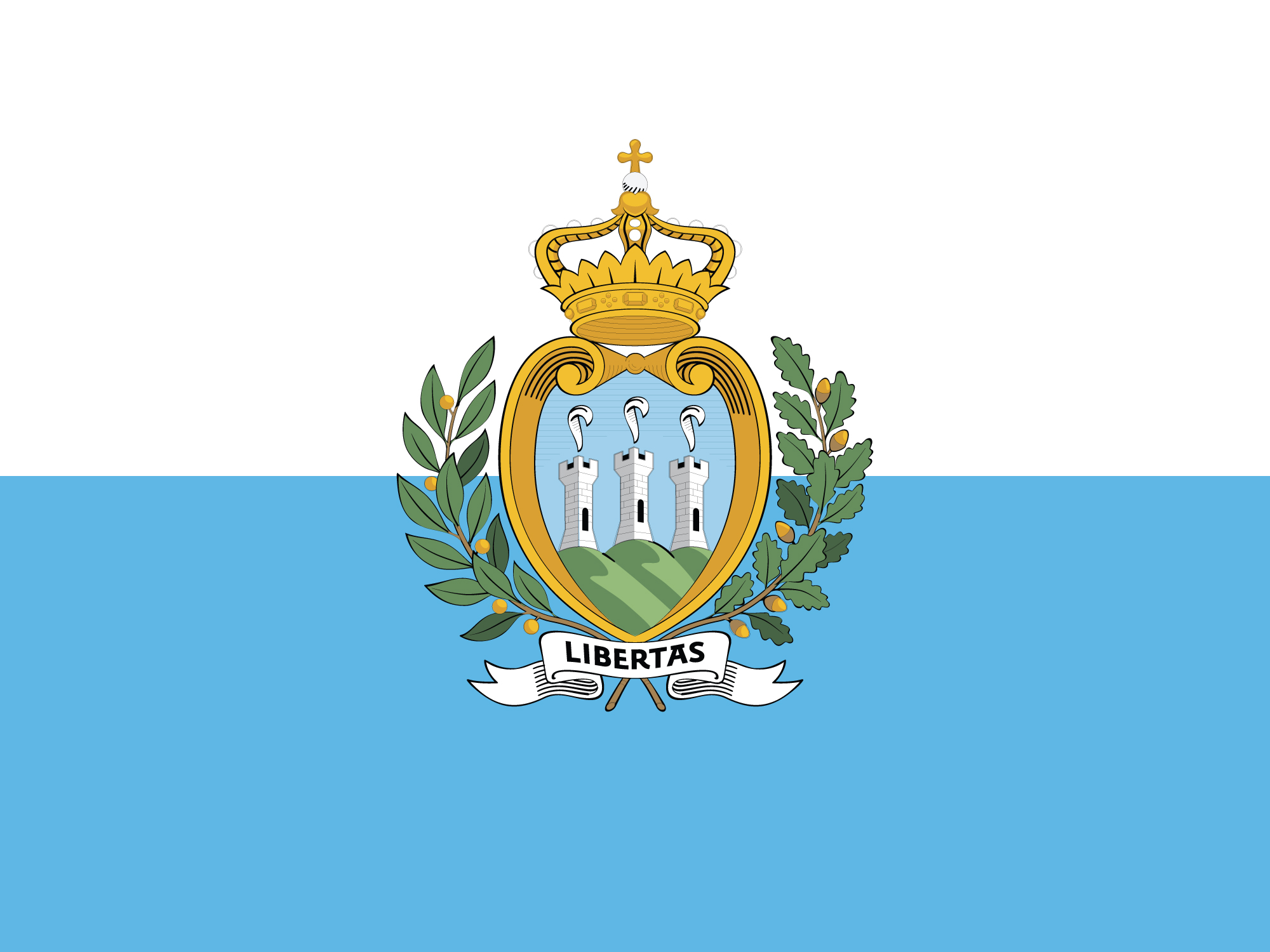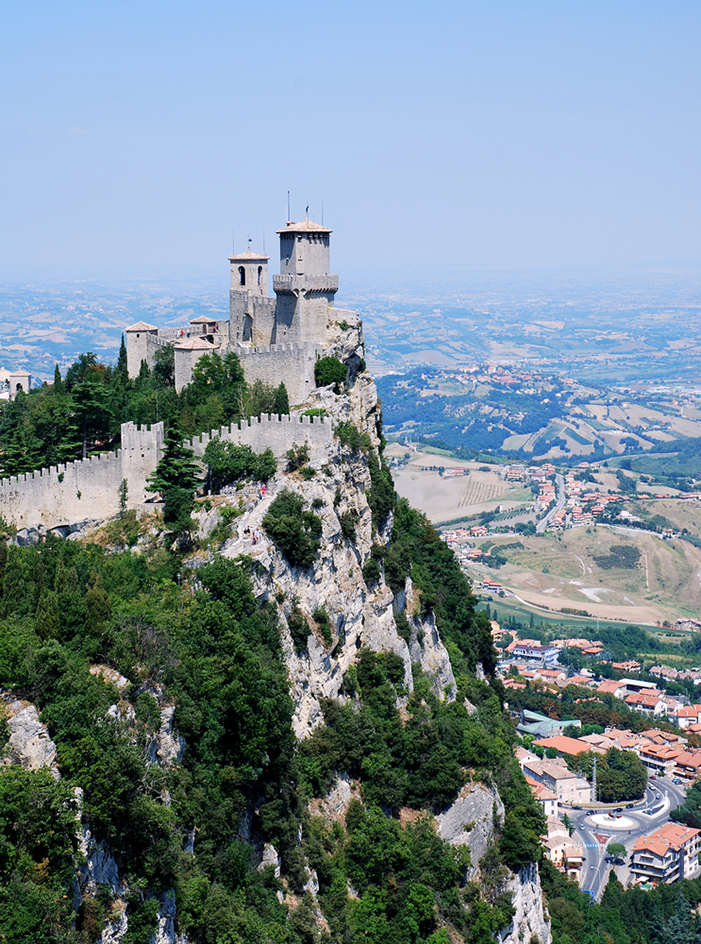San Marino, << `san` muh REE noh, >> is a small European country that is surrounded by Italy. It lies in the Apennine Mountains of northeastern Italy. Much of it—including its capital and largest city—stands on Mount Titano. The capital is also called San Marino. San Marino is one of the smallest countries in the world. It covers only 24 square miles (61 square kilometers).

San Marino is the oldest republic in the world. The country has been independent since the A.D. 300’s. Its official name is La Serenissima Repubblica di San Marino (The Most Serene Republic of San Marino).
San Marino is a popular tourist center. Visitors enjoy the country’s spectacular views, fortress walls, cakes and wine, and colorful festivals. San Marino is also known for its beautiful postage stamps.
Government.
San Marino is a republic. A legislature called the Grand and General Council makes the country’s laws. The people elect the 60 council members to five-year terms. The council selects two of its members to serve as the head of state. These two officials, known as captains-regent, serve for six months and cannot be reelected for three years. The Grand and General Council appoints the heads of the 10 departments of the government. The captains-regent and heads of the government departments make up the Congress of the State.

People.
San Marino’s people are closely related to the people of northern Italy. Nearly all San Marinese are Roman Catholics and speak Italian, and their customs are like those of Italy. However, the people of San Marino are proud of their long tradition of independence, and many of their holidays honor events in the nation’s history.
Many of San Marino’s people work in the tourist industry, which includes hotels, restaurants, and souvenir shops. Other people work in stone quarries or make leather or cheese. San Marinese farmers raise cattle and sheep and grow such crops as grapes and wheat.
Loading the player...San Marino's national anthem
Nearly everyone in San Marino can read and write. The law requires children from the ages of 6 to 14 to attend school. After elementary and secondary school, many students attend schools of higher education in Italy.
Most homes have a radio, telephone, and television. More than half the population uses cellular phones.
Land.
San Marino lies in the rugged terrain of the eastern Apennine Mountains near the Adriatic Sea. Mount Titano, the country’s highest mountain, is 2,478 feet (755 meters) high and has three peaks. On top of each peak is a tower built during the Middle Ages. The capital, San Marino, is near the top of the mountain. A highway links the country with Rimini, the nearest Italian city. A helicopter service provides transportation to and from Rimini during the summer.

San Marino has a mild summer climate, with a temperature that averages about 75 °F (24 °C). Winter temperatures sometimes fall below freezing. The country has an average annual rainfall of 35 inches (89 centimeters). The soil in San Marino is poor and rocky. However, the mild climate and ample rainfall enable farmers to grow a variety of crops.
Economy.
Banking and manufacturing contribute much to San Marino’s economy. Manufactured products include ceramics, textiles, and tiles. San Marino’s economy benefits from the approximately 2 million tourists who visit the country each year. Italy is San Marino’s main trading partner. Building stone and lime from mountainside quarries are exported to Italy. Agriculture plays a minor role in the country’s economy. The principal crops include corn, grapes for wine, and olives and wheat. Farmers also raise cattle and hogs.
Other sources of income for San Marino are the sale of coins and postage stamps and an annual payment from Italy. San Marinese coins and postage stamps are prized by collectors throughout the world. The Italian government pays San Marino for certain privileges. These privileges include the right to tax San Marinese goods shipped through Italian ports and to supply all of San Marino’s salt and tobacco.
History.
According to tradition, San Marino was founded in the A.D. 300’s by a Christian stonecutter named Marinus. Marinus, for whom the country was named, fled to Mount Titano to escape religious persecution by the Romans. An independent religious community had grown up in San Marino by 885, and a republic was established by the 1300’s. During the next 200 years, the citizens of San Marino defended their republic against plots by, and attacks from, neighboring states. In 1631, the independence of San Marino was formally recognized by the pope, who controlled the surrounding territory. Later popes opposed attempts by some Italian cardinals to take over the tiny country.
The territory surrounding San Marino became part of the kingdom of Italy in 1861. San Marino and Italy signed a treaty of friendship in 1862. Renewed in 1877, this treaty has governed relations between the two countries since that time. During most of World War II (1939-1945), San Marino was officially neutral, but Fascists controlled the government. The British bombed the country once in 1944.
From 1945 to 1957, a coalition of Communists and Socialists held a majority of seats in the Grand and General Council. The Christian Democratic Party gained control of the council in 1957 and governed the country for the next 20 years. Since the elections of 1978, a coalition of Communists, Socialists, and others on the political left has usually held power.
See also Emilia-Romagna .
